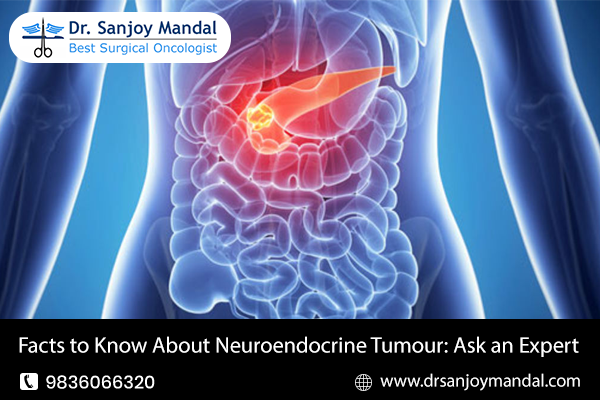Neuroendocrine tumours (NETs) are rare but can occur anywhere in the body, originating from neuroendocrine cells. These tumours can be benign (non-cancerous) or malignant (cancerous). Here are some key facts to understand about neuroendocrine tumours as stated by the best neuroendocrine tumour treatment doctor in Saltlake, Kolkata:
What is a Neuroendocrine Tumour?
Neuroendocrine tumours arise from neuroendocrine cells found throughout the body, especially in organs like the gastrointestinal tract, pancreas and lungs. These cells release hormones into the bloodstream to regulate various bodily functions.
Types of Neuroendocrine Tumours
- Functional NETs: Some neuroendocrine tumours produce hormones that cause specific symptoms, such as flushing, diarrhoea or wheezing, depending on the hormones released.
- Non-functional NETs: These tumours do not produce hormones, so they may not cause symptoms until they grow large enough to compress surrounding tissues or organs.
Symptoms and Diagnosis
- Varied Symptoms: Symptoms of neuroendocrine tumours vary depending on their location and whether they produce hormones. Common symptoms include abdominal pain, diarrhoea, unintended weight loss and more.
- Diagnostic Tests: Diagnosis typically involves imaging tests such as CT scans, MRI or PET scans and blood tests to measure hormone levels. A biopsy may also be performed to confirm the diagnosis.
Treatment Options
- Surgery: Surgical removal is often the primary treatment for localized neuroendocrine tumours. This may involve removing the tumour itself or, in some cases, the entire affected organ.
- Medical Therapy: For metastatic or incurable tumours, medical therapy such as chemotherapy, targeted therapy or hormone therapy may be recommended to shrink the tumour or slow its growth.
- Radiation Therapy: Radiation therapy may be used to target and destroy cancer cells, especially in cases where surgery is not an option or to relieve symptoms such as pain.
- Peptide Receptor Radionuclide Therapy (PRRT): This emerging treatment uses radioactive substances to target and kill neuroendocrine tumour cells while minimizing damage to surrounding healthy tissues.
Check the Results
- Varied Prognosis: The prognosis for neuroendocrine tumours depends on factors such as the tumour’s size, location, grade and whether it has spread to other parts of the body.
- Survival Rates: Survival rates for neuroendocrine tumours vary widely, with some slow-growing tumours having a good prognosis and others being more aggressive.
- Regular Monitoring: Even after treatment, patients with neuroendocrine tumours require regular monitoring to detect any recurrence or progression of the disease.
If you or a loved one has been diagnosed with a neuroendocrine tumour, it’s essential to consult with the best neuroendocrine tumour treatment doctor in Saltlake, Kolkata. They can provide personalized treatment options and guidance tailored to your condition and needs. Early diagnosis and appropriate treatment can improve outcomes and quality of life for individuals with neuroendocrine tumours.
